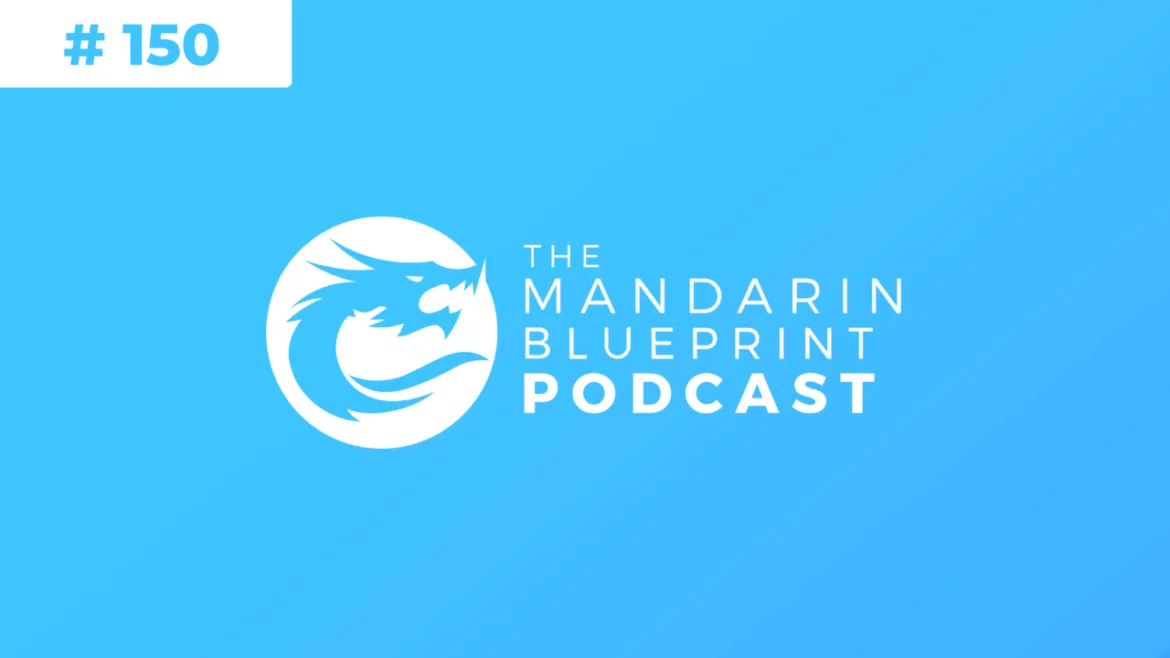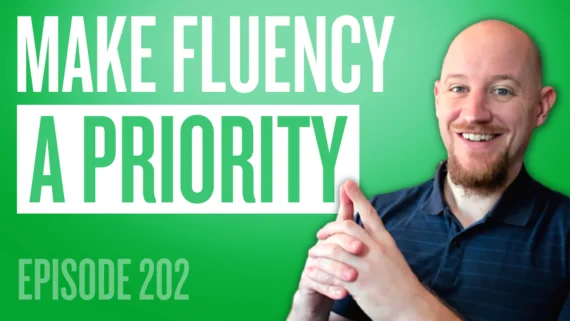
150. Learning 100 Chinese Characters a Day
欢迎光临! Welcome!
You can now subscribe to the podcast by the links below, or you can subscribe by copying the following URL into your favorite podcast APP.
The Mandarin Blueprint Podcast focuses primarily on The Blueprint online curriculum. Creators Luke Neale & Phil Crimmins answer questions and comments, discuss topics related to China and Mandarin learning, and have special guests.
Want to learn how to speak fluent Chinese fast? Join our free Webinar right here.
欢迎光临! Welcome!
You can now subscribe to the podcast on iTunes, Stitcher, Spotify, or you can subscribe by copying the following URL into your favorite podcast APP:
https://www.mandarinblueprint.com/feed/podcast/
The Mandarin Blueprint Podcast focuses primarily on The Mandarin Blueprint Method online curriculum. Creators Luke Neale & Phil Crimmins answer questions and comments, discuss topics related to China and Mandarin learning, and have special guests.
0:00 Affiliate Link & Reviews
Become a Mandarin Blueprint Affiliate
Leave us a Google Business Review 🙂
0:04 Comments & Emails
Tammy Liu on Now Just LOOK at how SOLID that Foundation Is! Phase 5 Complete!
I’m super excited to reach this milestone in my Mandarin learning journey! It’s been amazing to see the progress from the beginning where I could barely recognize any words and barely read sentences, to now where I can read entire stories!
It really hit me that this was working when I was able to read my family’s Weixin messages without a dictionary and also reply without a dictionary. I’ve been dreaming of this moment for years and now I’m here – and more excited than ever to continue on to the Intermediate course. I’m so glad that MB was able to keep me excited to learn as I think that’s the big missing factor in so many other courses (though I also really paced myself by taking 1 year + 1 month to get here).
Mandarin Blueprint is so good that I wish I had something similar for the other languages I want to learn (opportunity for expansion maybe?). Thank you Luke and Phil for the course, for keeping us motivated, and for really helping change so many people’s experiences with language learning and Mandarin!
6:37
George Johnstone by Email
Hi Luke & Phil
Thanks for your email. I’ll maybe do a more complete review when I finish Phase 2, but here are a few observations for now.
Before I started out with the Movie Method, I was aware of the memory techniques used, so I didn’t doubt that they could work. But I did have doubts about whether they were the right methods for me. Now I’m convinced.
I’m now part way through Phase 2. I think at the very beginning of the Characters course I was a little disappointed because I had mistakenly thought that simply creating the movie would magically fix it in my head. I now realize that it’s a combination of the initial creative process followed by the flashcards reviews that fully implants the movie. It might be useful to video a comparison of two people learning the same set of characters, one by traditional rote learning the other using the movie method to use as promotional material to help overcome potentital initial resistance to your ‘weird’ (but wonderful:-) method.
Although I’m still going through characters I mostly ‘know’, there are many gaps in my ‘knowledge’ especially tones and sometimes character components. I really appreciate how, with the movie method, frequently just one prompt (it might be a prop, a set or an actor) is enough to bring the whole movie to mind and thus all the information relating to that character (initial, final, tone, meaning, components). I’m assuming that later on when I really do ‘know’ a character the movie becomes less important as recall becomes more automatic and effortless, but the movies will always be there as backup.
My imagination has come to life and my movie making is certainly getting quicker. Where my early movies often showed the keyword in an utterance of the actor, I’m increasingly able to express the keyword in visual form or through action, which is more memorable. So my movies seem to work although I’m not going to be winning any Oscars. Some of my movies might be considered for Monty Python sketches and there’s also quite a few X-rated ones as well.
I’ve been through the video lessons for the Pronunciation course twice and now I’m just continuing with Anki reviews for that as well as the two additional decks for tone pairs and minimal pairs. I’m looking forward to slightly more meaningful practice working with full sentences.
I know that you recommend leaving writing for later and limit writing practice to hand writing the character with each movie review in Anki. I find that is enough for reinforcing stroke order and often I just write on the table with my finger for that. But I find that I need additional practice to really establish the muscle memory and a feel for the relative position and proportions of the components in the written characters (which is what is going to lead to nice handwriting). So I make myself a practice writing sheet at the end of each level and use that for daily practice until I move on to the next level. I’m trying to do as much foundation building for writing as I’m doing with pronunciation work as a foundation for spoken output later. I know this is perhaps not for everyone but I ‘enjoy’ it, especially when my characters begin to look half-way decent. With writing I think it’s partly the challenge that appeals to me. Nobody really writes by hand that much any more and I know my English handwriting has deteriorated. To think I used to hand write my university essays back then 😉
I think I mentioned in one of my community comments that when I started MB I dropped nearly all of my other study activities to focus on MB I’monly continuing my extensive listening and reading. There were a lot of those activities and it was becoming a bit of a chore to remember and manage all of them. As a result, for now MB is more like a holiday. I’m certainly studying in a much more relaxed way than I was before and that can only be good.
I thinks that’s about it for the moment, feel free to quote any of this if you want and as I said I’ll hopefully write a more detailed Google review at the end of Phase 2 or perhaps a little way into Phase 3.
Thanks for putting this course together and all the best. 保重
17:17
Lauren Gathman on It’s a Word! 干
Is this method useful if you are already at a lower intermediate level and can read graded readers?
21:45
Lynn Ford on 所以 in Context
So we have been getting these stories sentence by sentence and I just unlocked the sentence : 男人又说:“ 其实这三颗种子是死的,它们开不出花。大儿子和二儿子为了公司,选择换了种子来骗我。但是小儿子选择了诚实,所以他没有花。Mind BLOWN! I just yelled out loud “OMG the seeds were DEAD the WHOLE TIME!”
I didn’t see that coming! A total drama, so much tea to unlock this morning 😉 Also… super clever of the father.
LOL, these stories are fun to unlock this way!
25:33
John Nomura on Make a Movie 规
Did I read that right? You can learn 100 characters per day. So, how much time per character? Just curious. I heard another MBP student say something similar. I just can’t fathom that.
27:06
Keith Travis on Make a Movie 规
In short: yes.
However, let me put it another way that makes it seem ridiculously easy while giving a more realistic idea of the actual level of proficiency in a day.
Bearing in mind that each individual must adapt to the various aspects of challenge in these processes in accordance with – favoring IMO – their strengths, (at least at first), here below is my own fundamental process apart from how I engage the innumerable ‘in-between’ subtleties of making associations.
Step 1) Beginning with a new level, simply write each character down once, (or 2 or 3 times to get it right if needed) Also write the pinyin and English next to it for easy reference later.
– that’s 50 characters per level give or take a few. It’s important to do this for just the selections of a single level since they have been arranged by Luke and Phil to be in optimal order and similarity for learning.– while writing them down, some associations will inevitable occur to you without effort, although nothing really comprehensive. That’s fine. Maybe the beginning of a Hanzi scene will tease out, but no need to focus on it yet.
This takes less than an hour easy.
Step 2) Set that shingle page of notes aside. It should easily fit onto one side of one sheet of paper. I used college ruled paper and had two columns of characters-pinyin-english. Write small. Use a very fine pen.
Step 3) Take a break.
Step 4) Review that sheet of notes, taking more time to mentally consider the Hanzi scene. Most important is to fix upon the Actor and Setting. After that, use whatever works best for you but try to be brief and give each scene only bare-bones consideration @30-45 seconds and move to the next.
– This takes about 30-45 minutes.
Step 5) Take another break.
Step 6) Unsuspend those cards on Anki and review them together as one session without interference from other cards. If you haven’t done your review of other cards for the day yet, finish that before starting the new level.
– As you go through this new level of characters on Anki, some of your brief scenes will reveal themselves to have already been effective and some not. Regardless, you will get to see each card twice and and each character-and-English-and-Pinyin 4 times total as there are Hanzi–>[Pinyin+English] cards as well as [Pinyin+English]–> Hanzi cards. You always have the option to select ‘again’ on Anki if you need to continue recylcing a card before getting it correct…or close enough by your judgement.
– This takes another @30 minutes.
Step 6) Congratulations, you have reviewed each character at least 6 times by now and have written it down at least once, now knowing full well in your mind that you have an initial grasp of every aspect of the character.
– repeated reviews will continue to reveal things to your attention, how to tweak your associations..
Total time with breaks: @2 hours to 2.5 hours.
Yes, it makes for a longer study day to do this twice of course (about 5 hours) but it is not too mentally draining in having broken the steps down a bit. You can easily imagine doing 3 levels in a day this way…or 4.
The final observation here is: and how effective will it be in tomorrow’s review?
If you take your time with your Anki review the next day, you should find your retention at at least 85% – 95%.
If you try to rush your Anki review, it will of course lower your apparent retention.
Personally, my subsequent reviews averaged out around 13 seconds per cards and 92% retention.
At which point, I recommend you consider how to reduce the time/per card while increasing the accuracy.
Best example of this is with the ‘minimal pairs’ deck with a simple phoneme like { sa1 vs za1 }. I was fairly good at these cards from the get-go, yet with practice was able to reduce my time to below 2 seconds/card with 99+% accuracy. At about that threshold of pace and accuracy, my brain started to wire for automaticity and now I have an almost completely automatic and accurate pinyin inner-mental subtitle pacing along with everything I listen too.
My goal now is to try and discover similar ‘automaticity threshold’ levels for both the forward and reverse processes of the two types of vocab cards.
Good luck!
36:44
bubu on Level 12 Complete, Phase 2 Complete!
I have been enthusiastically doing my Anki reviews on a daily basis with 200 words with ease. Is this the normal figure for most? i find that I could do much more but am not sure or familiar with how Anki works best. I do have the capacity to do more. Please advise how I can revise everything? Not all the cards appear for review though. I tend to hit more of the Blue and Green buttons during review. Also, I find that I tend to skip the movie review when I can instantly recognize a word or character. Is this normal? or do I still go through the movie in my head?
40:25
Jessie Johnson on Level 2 Complete
I just wanted to drop a note and say how much I’m enjoying the method. Luke and Phil have really created something special and I hope you both feel very proud of your work. I’m certainly very appreciative of all the time and care you obviously put into this.
I’m kind of introverted, so I don’t comment often. But whenever I come up with something unique I’ll try to share so that maybe others can benefit as I have from all the wonderful suggestions in the community. Thank you, everyone.
41:32 Vocab Living Links
This section covers “Living Link” mnemonic techniques to remember Chinese words of two or more characters. Here’s a video explaining the theory behind it.
Brennan Pimpinella on Vocab Unlocked from 字: 汉字
Eyyyyy finally made it to the 汉字 in the HanZi Movie Method!
45:18
Alfred Hong on Vocab Unlocked from 没: 没什么 – 没关系 – 从来没
从来没 I was wondering for some time what image I could use here. I ended up choosing an image from Men In Black where Will Smith’s and Tommy Lee Jone’s characters are wiping someone’s memory.
46:05
Chris Lewis on Vocab Unlocked from 床: 起床
This sounds like Cheech and Chong, an old TV series from the 80’s
47:19
Chris Lewis on Vocab Unlocked from 应: 反应
Sounds like fanning, when it’s really hot outside the reaction to the heat is to fan yourself
48:15
Korneel Snauwaert on Vocab Unlocked from 能: 能力 – 可能
A poem:
Does Bruce Lee
Have nénglì?
50:15
kym Thomas on Vocab Unlocked from 意: 意思 – 介意 – 同意 – 有意思 – 没意思 – 不好意思 – 注意 – 做生意 – 意外
有意思, I used Jason Lightfoot a British Youtuber who calls himself A.K.A MR 有意思 among other nicknames.
1:01:53
Jeff Johnson on Vocab Unlocked from 两: 两(个)
I was searching for a good mental image to go with this and came across a matched set of Dueling pistols. I thought it was very interesting for this word.
1:02:45
Rick Angleland on Vocab Unlocked from 成: 完成 – 成长 – 变成 – 成为 – 成人
re 完成:
Now I can understand the sentence that is recited in every Assimil lesson, and which could also be said about each MB grammar building cloze card: 完成句子。


